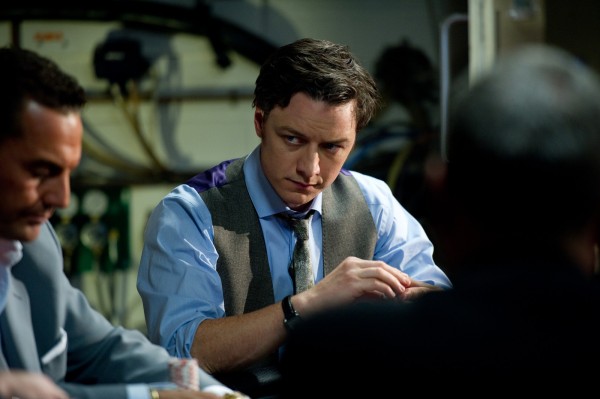
In the closing credits of Danny Boyle’s film, Trance, time winds back on itself to reveal the lifecycle of a painting in reverse: paint is stripped away, layer by layer, figures devolving into amorphous blotches of colour, until only a blank canvas remains. It’s a clever flourish for a film obsessed with perception and memory—and that’s part of the problem. In Trance there is no substance—only style.
Art auctioneer Simon Newton (James McAvoy) is a compulsive gambler on a very long losing streak. To pay off his debts, he agrees to help ruthless criminal Franck (Vincent Cassel) and his gang steal Goya’s Witches in the Air from his own London auction house. Everything goes according to plan until Franck finds he has stolen an empty frame: Simon double-crossed him and hid the canvas. Unfortunately, a blow to the head has left Simon with amnesia and even after copious torture, he can’t remember where he put the painting. Franck enlists hypnotherapist Elizabeth (Rosario Dawson) to root around in Simon’s subconscious and find the canvas.
Before its associations with hypnosis and semi-consciousness, the word “trance” originally meant “a state of doubt or suspense.” How appropriate for a film that revels in its own complexity. Trance is a needlessly convoluted series of plot twists, with each “revelation” more confusing than the last. Is Simon asleep or is he awake? Was that reality or fantasy? Do you still care?
Yet it all starts so well. Simon speaks directly into the camera as he explains the history of auction house thefts and the procedures put in place to prevent them. “Anyone can steal a painting,” he tells us conspiratorially, but “no piece of art is worth a human life.” So when Franck and his men burst in armed with tear gas, guns and a baseball bat, we see precisely what we expect to see: an immaculately executed heist, underpinned with sleek cuts and a pumping electronic score—until that empty picture frame. It’s an exhilarating sequence that belongs in a better movie.
Not that the rest of the film lacks confidence either. Simon is extremely susceptible to hypnotism and Boyle seizes every opportunity to blur the lines of reality and remind us that we are watching a movie. Shots both in and out of trance are so saturated in colour that they appear hyper-real, while scenes blend into and loop back on each other without warning. Elizabeth tries to coax Simon into revealing his secrets by having him imagine and unwrap a package containing his memory: he finds an iPad that lets him watch and replay events as if he were watching a film.
Boyle is so fascinated with his own sleight of hand that he almost forgets he has a story to tell.
Fortunately, the film’s cast helps keep it grounded. James McAvoy’s big blue eyes project a wounded innocence that ensures Simon remains sympathetic, sadistic streak notwithstanding. (In one scene, he torments one of his erstwhile torturers—making him believe he is being buried alive—and is almost titillated by the other man’s suffering.) Vincent Cassel is also compelling as Franck, a stylish thug frustrated that events are increasingly spiralling out of control, while Rosario Dawson does her best to be an implacable, mysterious femme fatale, and sometimes succeeds.
With its anachronic storytelling and brain-rattled protagonist, Trance invites comparison with Christopher Nolan’s Memento, a Möbius strip of a detective movie in which viewers are never certain how much of what they see is real. Nolan presents us with a puzzle to solve, but carefully ties it to a lead character with whom we cannot help but empathize: a grieving husband searching for his wife’s killer. Unfortunately, Boyle’s film doesn’t wield the same emotional heft and his self-conscious flourishes deliberately keep his characters at arm’s length.
Trance is thus a labyrinth of fancy camerawork and tortuous plot twists with a hollow heart. The audience’s confusion is intentional; its disaffection is not.
Leave a Reply